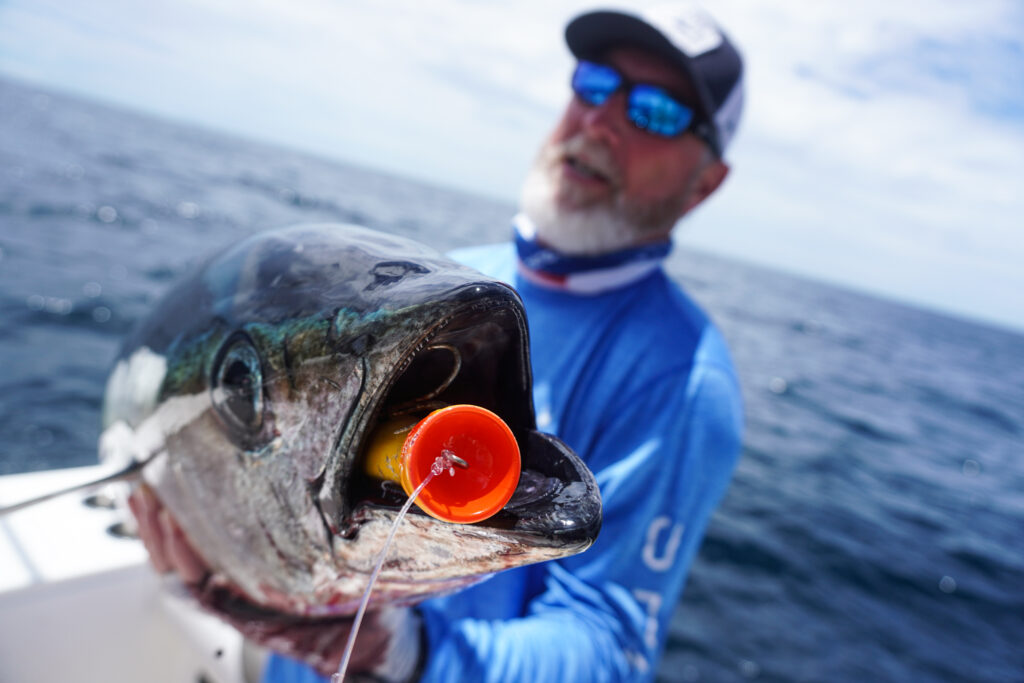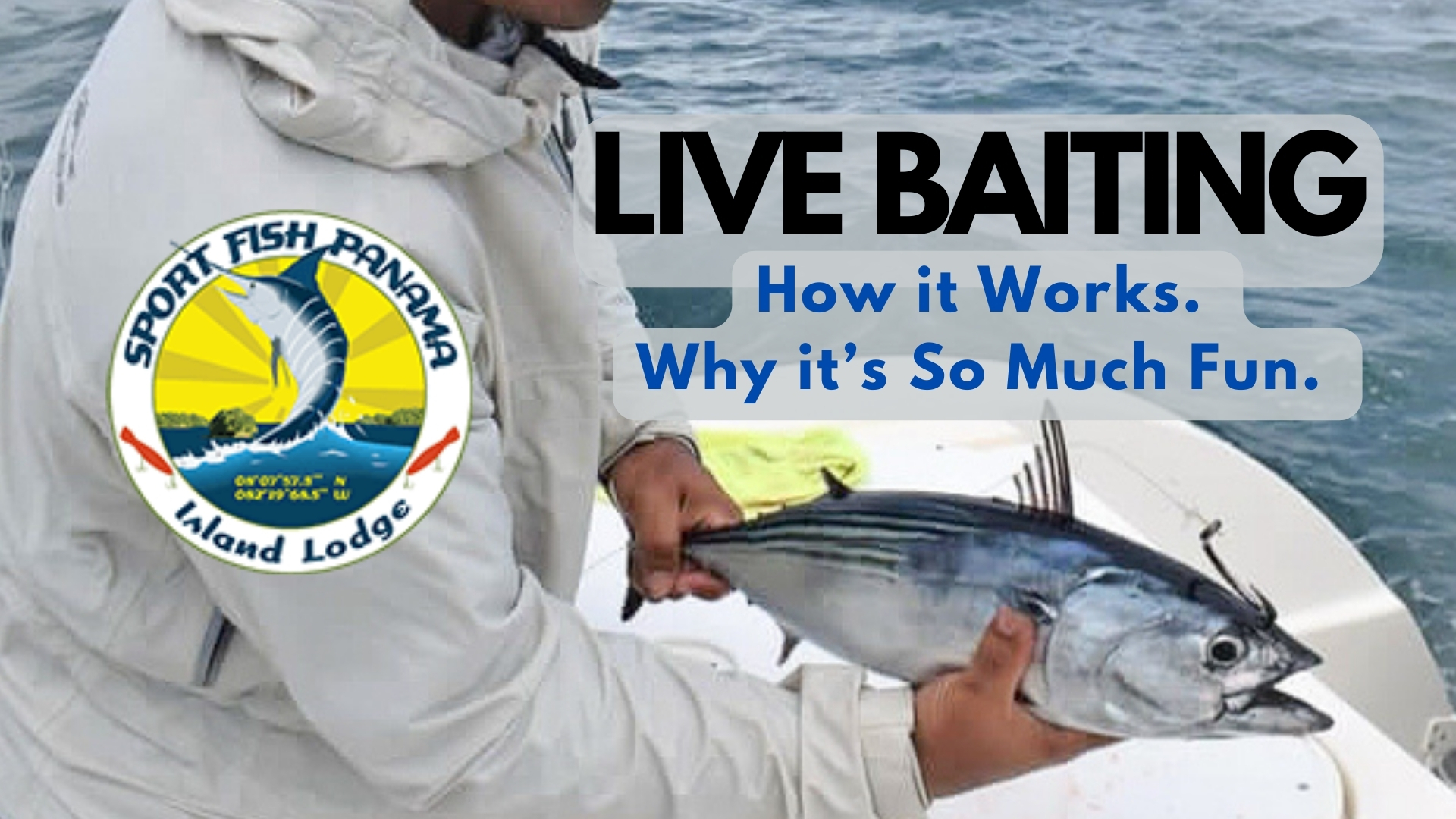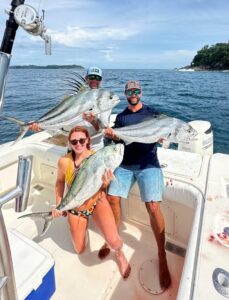At the Sport Fish Panama Island Lodge we’re literally surrounded by one of the best yellowfin tuna fisheries in the world. The combination of size, number, year-round accessibility and short runs to the yellowfin is not matched by any place in the world.

Adding to our incredible location, our fleet of boats is tailor made for the tuna fishing here. Our four power catamarans are fast and maneuverable. Their bows are wide, stable and open—the ideal platform for casting poppers into tuna frenzies or at the leading edge of a pod of porpoises.
The gear we use is the best in the business. Catching big yellowfin tuna is hard work—its also Hell on equipment. Sea Mount harnesses, Accurate reels, Mustad hooks and Yo-Zuri lures are specifically designed for this brand of hand-to-hand combat.

When you combine the productivity of the waters we fish with the caliber of the boats and equipment we deploy, the result is one of the best and most well-rounded yellowfin tuna fishing experiences in the world. Consider:
- In parts of the Gulf and East Coast, you might run 80 or 100-miles (one way) to catch yellowfin tuna. Even then the fish are not likely to be as big or as plentiful as the tuna we catch.
- We catch yellowfin in a tropical paradise. Our waters are generally calm, we fish more sunny days than otherwise. There are plenty of tuna fisheries that are rough, cold, and require you to spend a night offshore on the boat.
- The Gulf of Chiriqui is perhaps the best place in the world to experience a tuna frenzy. These events are epic—perhaps the most exciting spectacle that fishing has to offer. They do not occur in many other parts of the world.
Our Brand of Tuna Fishing
Every year we host hundreds of anglers from around the world. We put many of them onto the best day of fishing they’ve ever had. Our incredible tuna fishery is a central part of this experience.
If you come down to fish with us, there are several methods that we use to catch yellowfin. Here is a breakdown of some of our favorite tuna fishing techniques and what makes them so much fun. We describe them here so that you can prepare for your trip and understand the process once you get here.
Run and Gun Tuna Fishing
The Gulf of Chiriqui is one of the best places in the world to run and gun for yellowfin. This is one of the most exciting ways of fishing. It involves positioning the boat in front of moving schools of tuna and casting into them. We often find schools of tuna under flocks of birds or moving with pods of porpoises.
Flocks of birds will often travel with schools of tuna. The birds wait for tuna to stack balls of bait near the surface where the birds can eat it. Each of our boats is equipped with Simrad radar units. These radars are ideal for our brand fishing. They have a “bird mode” setting that allows us to pick up flocks of birds at ranges much further than the eye can see.

When we find a flock of birds on fish, we’ll run over to intercept the fish. The lead up to this is very exciting. First you see the dive-bombing birds on the horizon. As we run up the action, we’ll get the poppers and live baits ready. By the time we’re casting onto the fish, we may be surrounded by birds crashing from the sky into the sea and piles of tuna mashing bait on the surface. It is an awesome sight.
Tuna Fishing on Porpoises
Tuna fishing on pods of spinner dolphins is equally exciting. We’ll often find groups of fish by looking for these dolphins as they jump 10 or 12 feet into the air, completing five or six complete rotations before re-entering the sea. When the dolphins move on bait, they will do so in a coordinated attack. It often involves a leading edge of dolphins swimming toward their prey.
The yellowfin move with them, though they seem less coordinated in their attack. When a group of tuna move on a bait ball it looks like chaos. When porpoises attack, they appear to be coordinated.

When we’re running and gunning for tuna on dolphins, we’ll position the boat at the leading edge of the pod. We’ll generally have a couple of anglers casting from the bow. We’ll often put a blue runner or live bonito out of the cockpit, too. When it goes right, we might hook one, two, three or even four tuna at the same time.
If we miss them, we’ll reposition the boat and try again. That’s where our power catamarans shine. The twin outboards are placed wide on the transom. Not only are they powerful enough to make the boats go fast, but this placement allows us to spin and maneuver the boats to stay with the tuna.
This is action-packed, interactive fishing. Do it once and you’re likely want to do it more often.
Tuna Frenzies
With apologies to every other type of fishing in the world, tuna frenzies might be the most exciting. Tuna frenzies do not happen every day—and only occur in a few places in the world. But seeing one can change your perspective on excitement and exhilaration.
A tuna frenzy happens when yellowfin stack bait on the surface, especially when the bait holds on a piece of floating structure. When there’s a school of yellowfin piles a large ball of bait on a floating piece of structure carnage can ensue.
Tuna frenzies in the Gulf of Chiriqui can be gigantic. Imagine two acres of ocean set about to a churning, foaming mass of tuna leaping and crashing out of the water. Imagine fishing aboard a boat that is literally surrounded by this wild, incredible spectacle.

Finding a tuna frenzy is a dream come true.
When they’re crashing ball of bait, there are times when you can hook a tuna nearly instantaneously—as soon as your bait hits the water. When we find a tuna frenzy, we will often take one of our specially made dip nets and scoop a basketball-sized mass of bait. We fill the bait tank and use them for bait—matching the hatch, feeding the tuna the same blue runners, goggle eyes or small triggerfish that they are consuming.
Another amazing aspect of these frenzies are the varied sizes of the tuna within them. Yellowfin often school with other fish of the same size. Many tuna frenzies take place with fish in the 70-100 pound class. If you think it incredible to watch fish of this size throw themselves out of the water, just wait for one of the real-ones to crash through the ball of bait. Watching the occasional 250-pounder make an appearance in the melee is just part of the magic of these incredible spectacles.
Live Baiting
Speaking of big yellowfin, live baiting with bonito is a great way to target large tuna. We deploy live bonito on our large conventional outfits, in much the same way as we do when targeting marlin.

When there’s lots of tuna around, the size of the live baits can keep them from getting eaten by smaller fish. We’ll also sometimes catch big tuna on live baits around structure, like the Hannibal Bank.
When a stud tuna eats a live bait, it’s a multisensory experience. The reels have their clickers engaged and will be set near free-spool as we bump troll the live baits. When a tuna strikes, the line pops out of the rigger and it sounds like the reel is going to explode. We’ll throw the lever drag to strike and hook the fish. The sound is just as loud and amazing as the tuna pulls drag from the engaged reel.

Live baiting for big tuna also ensures that you’re properly outfitted for a fight. A 50-wide can put a lot of heat on a big tuna. When fighting a 200-pounder, you’ll appreciate all the help you can get.
Trolling, Chunking and Other Ways to Catch Yellowfin
Beyond poppers, live baiting and fishing tuna frenzies, we have many ways to catch yellowfin. If we see tuna around and we’re trolling lures for marlin, we might add a cedar plug to the spread. Putting these on the shotgun and trolling it behind the remainder of the spread is a great way to pick up a yellowfin or a bonus sailfish or dorado.
If we mark tuna, but the fish are down deep, we can target them with vertical jigs or large soft baits on lead heads. Dropping these baits onto schools of suspended tuna can be a great way to make a big spinning reel sing. An added bonus is that the size of the fish is a mystery at the time of hook up. The fish can range from 20 to 275-pounds. Sometimes its first run gives away its size. Hooking a stubborn, big tuna in deep water and you might get to see the spool of the spinning reel.

In many parts of the world, chunking is the preferred method for catching yellowfin. This involves marking a school of tuna and chumming them out of the depths. It’s called chunking because you cut chunks of bait and toss it into the water. Every so often, you hook a chunk and let it drift naturally back with the unhooked pieces of bait.
This will sometimes draw a school of tuna from the depths. You’ll also hook fish on the pieces that drift back to the school. Because we so often find schools of tuna under birds, with pods of porpoise or in tuna frenzies, we do not chunk as often here as in many other yellowfin destinations.
Come Fish With Us
The yellowfin are here—big ones and lots of them. We catch them throughout the year. We’ve even established an annual award for the lodge guest who catches the biggest yellowfin each year.
We have lots of exciting ways to target these fish. The places where we encounter the tuna are among the most beautiful in North America. What’s more? These things are delicious. Our chefs turn them into an incredible array of sushi, sashimi, seared tuna steaks, poke and more. We can even vacuum seal some for you to take home.
We’d love to show you what it’s all about… And what it truly means to fish in one of the world’s best yellowfin tuna destinations.





